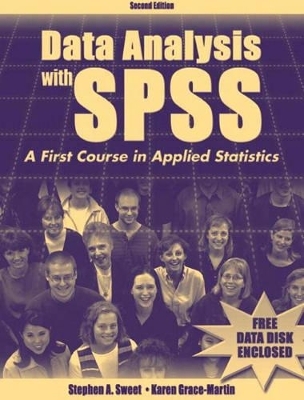
Data Analysis with SPSS
Pearson
978-0-205-34057-6 (ISBN)
- Titel erscheint in neuer Auflage
- Artikel merken
Data Analysis with SPSS is designed to teach students how to explore data in a systematic manner using the most popular professional social statistics program on the market today.
Written in ten manageable chapters, this book first introduces students to the approach researchers use to frame research questions and the logic of establishing causal relations. Students are then oriented to the SPSS program and how to examine data sets. Subsequent chapters guide them through univariate analysis, bivariate analysis, graphic analysis, and multivariate analysis. Students conclude their course by learning how to write a research report and by engaging in their own research project.
Each book is packaged with a disk containing the GSS (General Social Survey) file and the States data files. The GSS file contains 100 variables generated from interviews with 2,900 people, concerning their behaviors and attitudes on a wide variety of issues such as abortion, religion, prejudice, sexuality, and politics. The States data allows comparison of all 50 states with 400 variables indicating issues such as unemployment, environment, criminality, population, and education. Students will ultimately use these data to conduct their own independent research project with SPSS.
Each chapter begins with “Overview” and concludes with “Summary,” “Key Terms,” “References and Further Reading,” and “Exercises.”
Preface.
Acknowledgements.
About the Authors.
1. Key Concepts in Social Science Research.
Empiricism and Social Science Research.
Data.
Developing Research Questions.
Theory and Hypothesis.
Relationships and Causality.
2. Getting Started: Accessing, Examining, and Saving Data.
The Layout of SPSS.
Types of Variables.
Defining and Saving a New Data Set.
Managing Data Sets: Dropping and Adding Variables.
Merging and Importing Files.
Loading and Examining an Existing File.
Managing Variable Names and Labels.
3. Univariate Analysis: Descriptive Statistics.
Why Do Researchers Perform Univariate Analysis?
Exploring Distributions of Numerical Variables.
Exploring Distributions of Categorical Variables.
4. Constructing Variables.
Why Construct New Variables?
Recoding Existing Variables.
Computing New Variables.
Recording and Running Computations Using Syntax.
Using Compute to Construct an Index with Syntax.
5. Assessing Association through Bivariate Analysis.
Why Do We Need Significance Tests?
Analyzing Bivariate Relationships Between Two Categorical Variables.
Analyzing Bivariate Relationships Between Two Numerical Variables.
6. Comparing Groups through Bivariate Analysis.
One-Way Analysis of Variance.
Graphing the Results of an ANOVA.
Post-Hoc Tests.
Assumptions of ANOVA.
t Tests.
7. Multivariate Analysis with Linear Regression.
What Are the Advantages of Multivariate Analysis?
When Can I Do a Linear Regression?
Linear Regression: A Bivariate Example.
Interpreting Linear Regression Coefficients.
Interpreting the R-Square Statistic.
Using Linear Regression Coefficients to Make Predictions.
Using Coefficients to Graph Bivariate Regression Lines.
Multiple Linear Regression.
Other Concerns of Linear Regression.
8. Multivariate Analysis with Logistic Regression.
What Is Logistic Regression?
What Are the Advantages of Logistic Regression?
When Can I Do a Logistic Regression?
Understanding the Relationships through Probabilities.
Logistic Regression: A Bivariate Example.
Multivariate Logistic Regression: An Example.
9. Writing a Research Report.
Writing Style and Audience.
The Structure of a Report.
10. Research Projects.
Potential Research Projects.
Research Project 1: Racism.
Research Project 2: Suicide.
Research Project 3: Criminality.
Research Project 4: Welfare.
Research Project 5: Sexual Behavior.
Research Project 6: Education.
Research Project 7: Your Topic.
Appendix 1: STATES.SAV Descriptives.
Appendix 2: GSS98.SAV File Information.
Appendix 3: Variable Label Abbreviations.
Permissions.
Index.
| Erscheint lt. Verlag | 26.6.2002 |
|---|---|
| Sprache | englisch |
| Maße | 210 x 275 mm |
| Gewicht | 558 g |
| Themenwelt | Mathematik / Informatik ► Mathematik ► Computerprogramme / Computeralgebra |
| ISBN-10 | 0-205-34057-1 / 0205340571 |
| ISBN-13 | 978-0-205-34057-6 / 9780205340576 |
| Zustand | Neuware |
| Haben Sie eine Frage zum Produkt? |